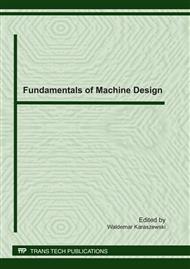[1]
R.T. Cundill, Rolling element bearings into 21st century, IMechE, Seminar, London, November, 1990.
Google Scholar
[2]
Y. Wang, M. Hadfield, The influence of ring crack location on the rolling contact fatigue failure of lubricated silicon nitride: experimental studies, Wear 243 (2000), 157-166.
DOI: 10.1016/s0043-1648(00)00435-x
Google Scholar
[3]
W. Karaszewski, The influence of oil additives on spread cracks in silicon nitride, Tribology International, vol.41, issue 9-10 (2008) 889-895.
DOI: 10.1016/j.triboint.2007.12.002
Google Scholar
[4]
Y. Wang, M. Hadfield, Failure modes of ceramic rolling elements with surface crack defects. Wear 256 (2004) 208-219.
DOI: 10.1016/s0043-1648(03)00409-5
Google Scholar
[5]
W. Karaszewski, Surface cracks of ceramic rolling elements, Acta Mechanica et Automatica, vol. 3, nr 1(7), 2009, 68-70.
Google Scholar
[6]
M.H. Aliabadi, D. P. Rooke, Numerical Fracture mechanics, Computational Mechanics Publications, Southampton and Kluwer Academic Publisher, Dordrecht, 1991.
DOI: 10.1017/s0001924000050557
Google Scholar
[7]
T.A. Cruse, Boundary Element Analysis in Computational Fracture mechanics, Kluwer Academic Publishers, 1989.
Google Scholar
[8]
A. Portela, M.H. Aliabadi, D.P. Rooke, The dual boundary element method: effective implementation for crack problems, International Journal for Numerical Methods in Engineering, 33 (1991) 1269-1287.
DOI: 10.1002/nme.1620330611
Google Scholar
[9]
Information on http://www.beasy.com
Google Scholar
[10]
Y. Wang, M. Hadfield, The influence influence of ring crack location on the rolling contact fatigue failure of lubricated silicon nitride: fracture mechanics analysis, Wear 243 (2000), 167-174.
DOI: 10.1016/s0043-1648(00)00436-1
Google Scholar
[11]
I. Bar-On, J.T. Beals, Fatigue 90: proceedings of 4th International Conference on Fatigue and fatigue Thresholds, vol. 2, Edgbaston, UK, 1990, 793-798.
Google Scholar
[12]
C. Cirel, T.A. Stolarski, Factors affecting the wear of ceramic balls, Wear 172 (1994) 191-196.
DOI: 10.1016/0043-1648(94)90287-9
Google Scholar
[13]
M. Hadfield, T.A. Stolarski, R.T. Cundill, S. Horton, Failure modes of ceramic elements with ring crack defects, Tribology International 26 (1993) 157-164.
DOI: 10.1016/0301-679x(93)90089-j
Google Scholar
[14]
Y. Wang, M. Hadfield, Failure modes of ceramic rolling elements with surface crack defects, Wear, 256 (2004) 208-219
DOI: 10.1016/s0043-1648(03)00409-5
Google Scholar
[15]
W. Karaszewski, Influence of ring cracks on fatigue in silicon nitride, Tribologia, R. 35 vol. 3 (2004) 159-168
Google Scholar
[16]
W. Karaszewski, Limitation of fatigue life of ceramic couples due to surface ring cracks, Tribologia, R. 40 vol. 2 (2009), 29-38.
Google Scholar


